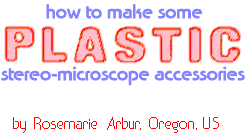 |
 |
| Recycle some plastic and make your pond-water explorations easier. |
| styrofoam wrist-rests |
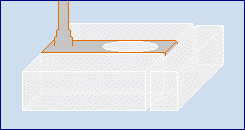 |
To steady your hands as you pipet (or grasp, or cut). They also enlarge the effective size of your stage so that petri dishes don't spill or fall off when you're looking at something that's close to the edge of the dish. The best way I've found to cut styrofoam is with a table- or radial-arm power saw; I know it seems like overkill, but the speed of the blade (or something) prevents the styrofoam from breaking into the little pieces that often make styrofoam annoying to work with. |
| I got my styrofoam from the packing a toaster came in, which I cut to be as thick as the stage of my stereo microscope is tall. You can glue thinner pieces together to get the right thickness and, if you're adventurous, even slant the side-pieces. I used paper-glue between pieces of styrofoam and then the cellophane tape designed for sealing boxes, which gave the styrofoam a thick, moisture-proof, and easy-to-clean surface. Surprisingly, the tape holds the styrofoam firmly enough that the U-shaped unit stays snug against the microscope's base and yet slides on and off easily. |
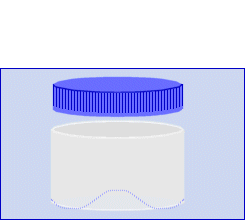 |
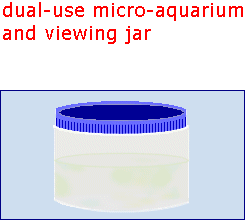 |
| The packagers of peanut butter
bring us a plastic jar and cap that couldn't be designed better. The bottom
of the jar (blue dotted line) is raised in the middle; with only the outer
part of the jar bottom in contact with the microscope's stage, the contents
of the jar do not heat up nearly so fast as do those of a flat-bottomed
jar or petri dish. The uneven heating causes little currents in the water
against the motion of which swimming micro-organisms are easier to spot.
By cutting the jar down to a size that fits under your objective you can view your micro-critters in the same container in which you keep them. This not only saves time but leaves the organisms undisturbed. The cap is especially neat. See how the vertical indentations in its side extend through the top plane of the cap but not the bottom. When the cap is upside down, it fits snugly inside the jar, and the vertical indentations allow air inside but not enough air for troublesome evaporation. |
| tilting tray / semi-mechanical stage |
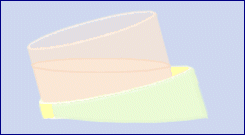 |
This tilting jar-holder used to be the bottom half of a plastic petri dish and a left-over piece of peanut-butter jar. (I've used colors in the drawing so the different parts are distinguishable.) Its main purpose is to tilt my water jar so that I can see critters adhering to the side of the jar without the distortion caused by the curve of the water surface where it meets the jar. | |
| It has an added benefit, the "semi-mechanical stage" feature. By leaving the tray stationary and keeping the jar against the low place on its rim, you can scan the jar's contents methodically by rotating the jar. Another: it raises the jar off the microscope's stage and keeps the water cooler. | ||
| To make one, first cut a paper template to see how to cut the piece of jar or other stiff plastic to get a good tilt (about a ½" difference between the height of front and back works). Then cut through the circumference of the piece of jar so that it will fit around the outside of the petri dish, and cut the plastic according to your template. | 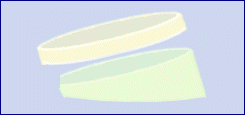 |
|
| Finally, fix the piece of jar to the outside of the petri-dish (I used the box-sealing cellophane tape around the entire underside of the dish and then at just a few points around the outside and top). | ||
|
|
| A regular watchglass can let heat from the substage lamp kill organisms in the few moments it takes to see if you succeeded pipetting them out of your pond-water jar. |  |
| One way to protect the organisms is to make a holder to raise the watchglass off the stage. The bottom of a sturdy plastic can that frozen juice comes in works well; easier to cut but less durable is the bottom of a styrofoam cup. You can glue a regular watchglass to the holder or keep it in place with a strip of cellophane tape across its bottom. |
 |
Or you can make a deeper, plastic "watchglass" from the container for little toys from vending machines (the one shown is an inch in diameter) or some other transparent or translucent plastic cup. | |
| Either way, the plastic base is wide enough not to tip over and large enough to be handled conveniently; and the watchglass, held away from the stage, won't heat up and endanger the lives of your specimens. | ||
Comments to the author Rosemarie Arbur welcome.
Please report any Web problems or
offer general comments to the
Micscape
Editor,
via the contact on current Micscape
Index.
Micscape is the on-line monthly magazine
of the Microscopy UK web
site at Microscopy-UK
WIDTH=1